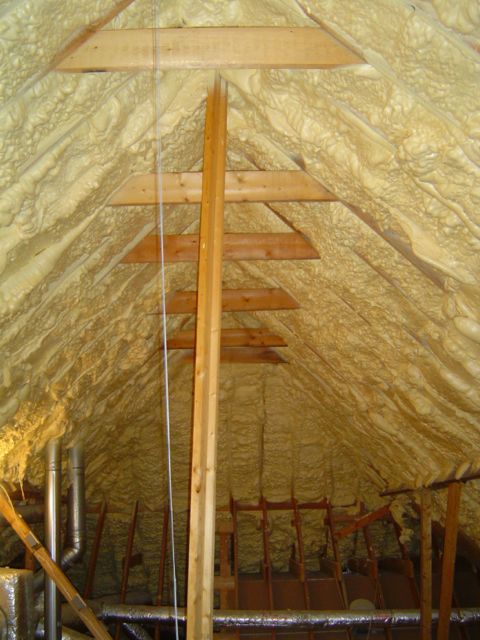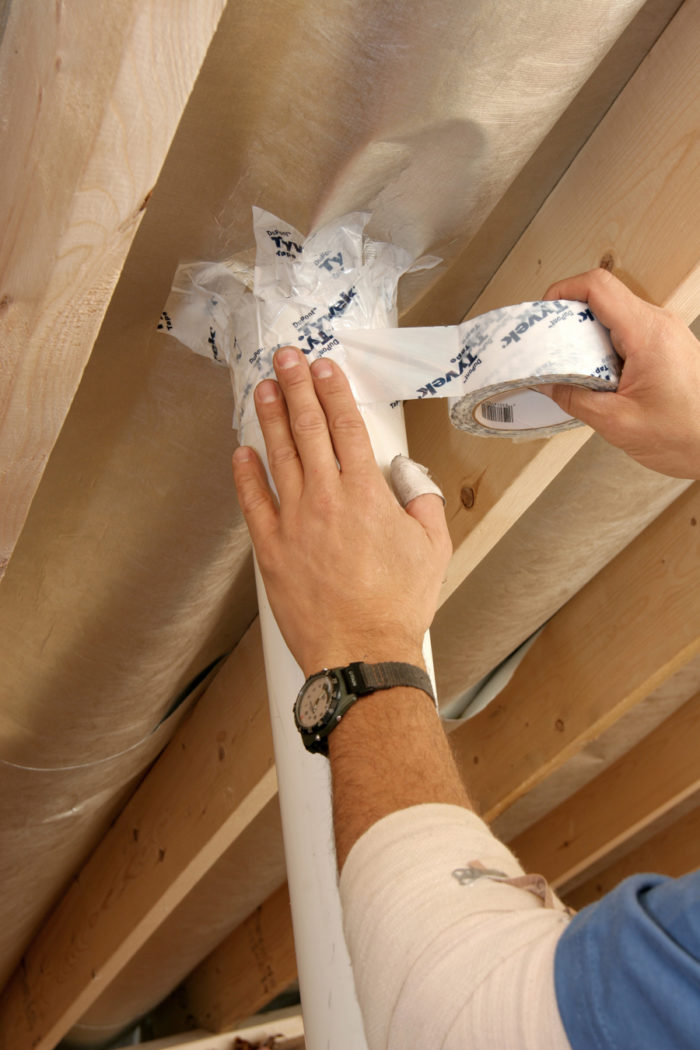
Image Credit: Energy Vanguard
What happens to the heating and cooling loads when you encapsulate an attic? With the insulation and air barrier at the ceiling below the attic, you’re excluding the attic space. That volume of air up there isn’t involved in the conditioning of the home. But when you move the enclosure to the roofline (usually by installing spray foam insulation beneath the roof deck), now the attic’s volume is included in the conditioned space.
Occasionally I hear people say the loads will be higher because of the extra volume. Does having more air inside really increase the loads?
A load calculation refresher
To understand this issue, let’s take a look at what goes into doing a load calculation. To do it right, you have to consider all the ways heat enters or leaves a home. Here they are:
- Enclosure loads – This is where most of the heating and cooling load comes from. It’s the heat that conducts through walls, windows, doors, ceilings, and floors. It’s also the radiant heat that comes (mainly) through the windows, also known as direct solar gain.
- Infiltration load – The air that leaks in through the building enclosure is really a sub-category of enclosure loads. But it’s worth separating it out, if for no other reason than it’s entered separately in the calculation.
- Ventilation load – The outdoor air you bring in for ventilation adds heat (both sensible and latent) in summer and results in heat loss in winter.
- System loads – When you put a heating or cooling system in unconditioned space, there’s heat gain in summer and heat loss in winter at the system. Likewise for the distribution system, whether you use air (ducts) or water (tubing). Duct insulation and sealing and pipe insulation help reduce those gains or losses, but you still have to include what’s left when you’re figuring the total loads.
- Dehumidification and humidification loads – All dehumidifiers give off heat. Most of them dump that heat into the space you’re dehumidifying. (An exception is the Ultra-Aire SD12,* which is a split-system dehumidifier.) Humidifiers need heat to vaporize the water. Sometimes that heat comes from the heating system itself, in which case it adds to the heating load.
- Internal loads – People give off heat. Lights give off heat. Appliances give off heat. You get the idea. Those things all get included, too.
By entering all the relevant details of the house under consideration, you get the loads for each room, each zone, and the whole house.
What’s air got to do with this?
So, which one of those loads is related to having a higher volume of air to heat and cool? Well, a couple of them are actually. When air leaks into a house, that unconditioned air has to be heated or cooled. Same with ventilation, except that in this case the “leakage” is intentional.
But the question here is about the effect that increasing the volume has on the load. When you encapsulate an attic and bring it into the conditioned space, the additional air in the attic doesn’t add anything to the load. If a sloppy spray foam job resulted in the attic not being airtight, then infiltration into the attic does add to the load, but that’s not what we’re talking about here.
Now, you may have more heating and cooling load when you encapsulate an attic, but it’s not because of the extra volume of air inside the conditioned space. When you move the enclosure to the roofline, you also increase the surface area of the home. That can increase the enclosure load. But if you’ve moved your HVAC system from unconditioned to conditioned space, you may end up with a lower load. In hot climates that can be significant.
Another factor that increases the loads when you encapsulate an attic is the insulation level. A lot of times, contractors will use a lower R-value for insulation on the roofline than they would on the ceiling below. (Martin Holladay wrote an article about this several years ago here on GBA.)
The problem here may be that the people who believe a bigger volume means a bigger load are confusing a correlation with causality. Hey, I get it. All my friends in Maine are trying to reduce their consumption of margarine because it’ll improve their chances of staying married. See the graph below, and you’ll be convinced, too. (See the website Spurious Correlations for more.)
Wait, no! That’s a correlation between two variables — but there’s not a shred of evidence that there’s a causal relationship between the two. Same here. We know what factors contribute to heating and cooling loads. The volume of air inside the home is not one of them.
* In full disclosure, Therma-Stor, which makes the Ultra-Aire line of dehumidifiers, advertises in the Energy Vanguard Blog.
Allison Bailes of Decatur, Georgia, is a speaker, writer, building science consultant, and the author of the Energy Vanguard Blog. You can follow him on Twitter at @EnergyVanguard.
Weekly Newsletter
Get building science and energy efficiency advice, plus special offers, in your inbox.















One Comment
It's not just in hot climates!
"But if you've moved your HVAC system from unconditioned to conditioned space, you may end up with a lower load. In hot climates that can be significant."
Hot air heating systems installed in unconditioned attics are a heating energy and ice-dam formation disaster in cold climates. Slab on grade builders seem to love putting the mechanicals in unconditioned attics, but it typically adds more than a ton to the peak cooling loads, and comparable or higher amounts to the peak heating loads in climate zones 5 & higher.
If codes simply prohibited ductwork & air handlers being located outside of conditioned space it would do a lot more for the peak loads & energy use of new housing than another continuous R5 of wall-R, and would cut down the frequency & severity of ice dam damage in snowy climates.
Log in or create an account to post a comment.
Sign up Log in